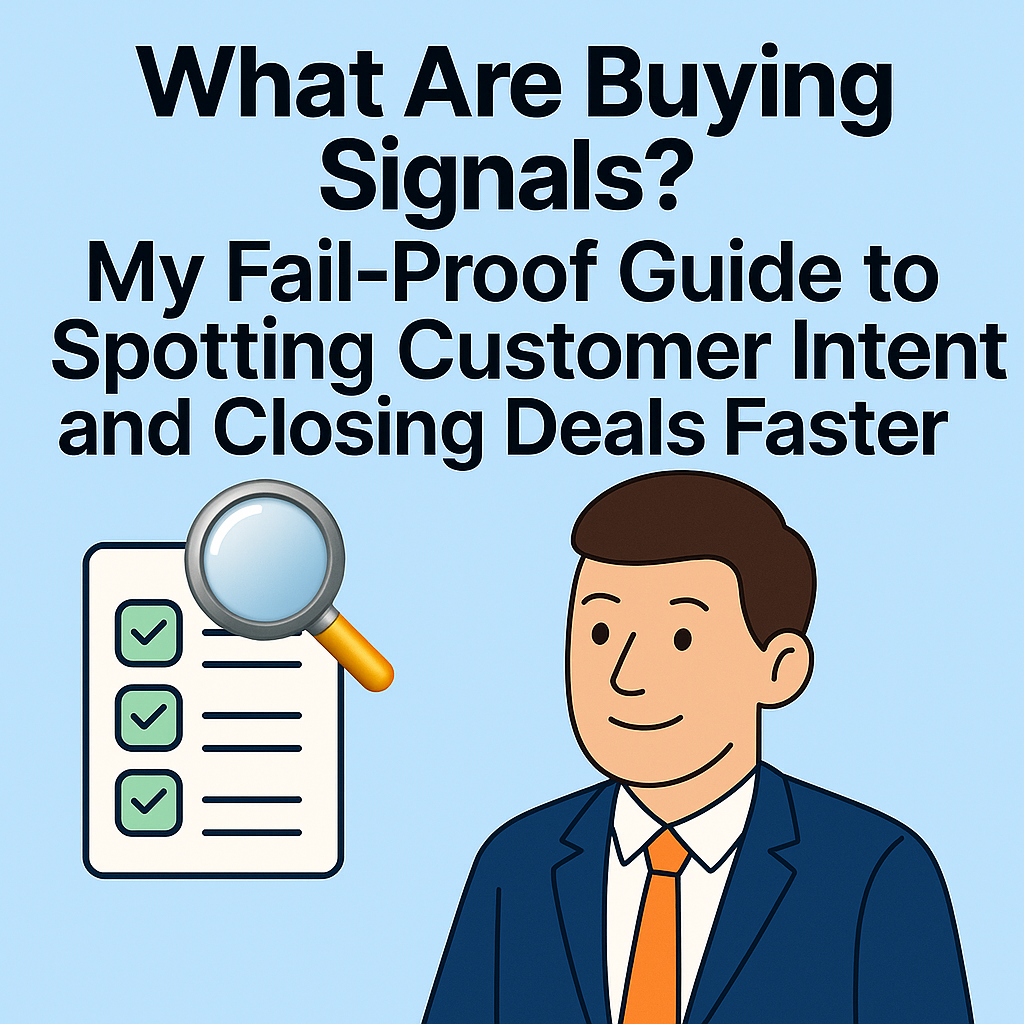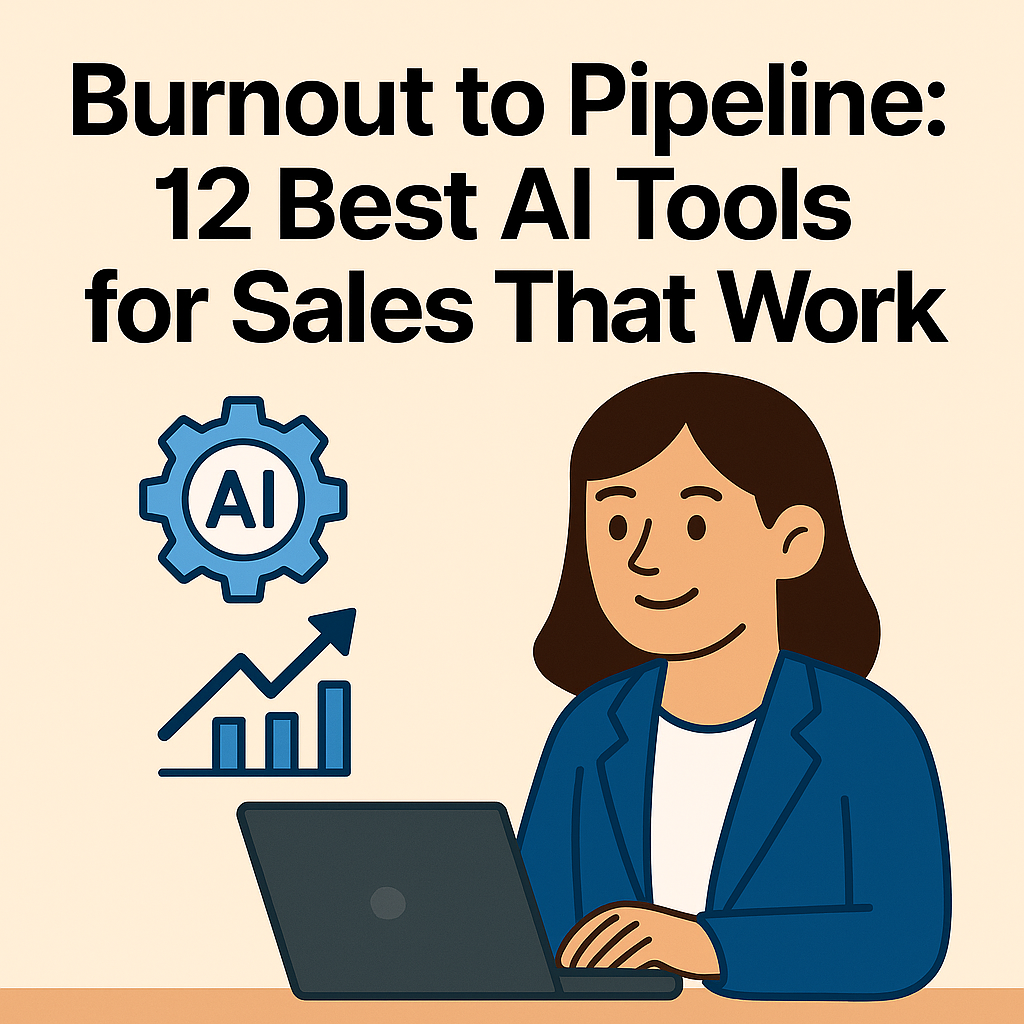Lead Scoring Best Practices I Wish I'd Known Sooner
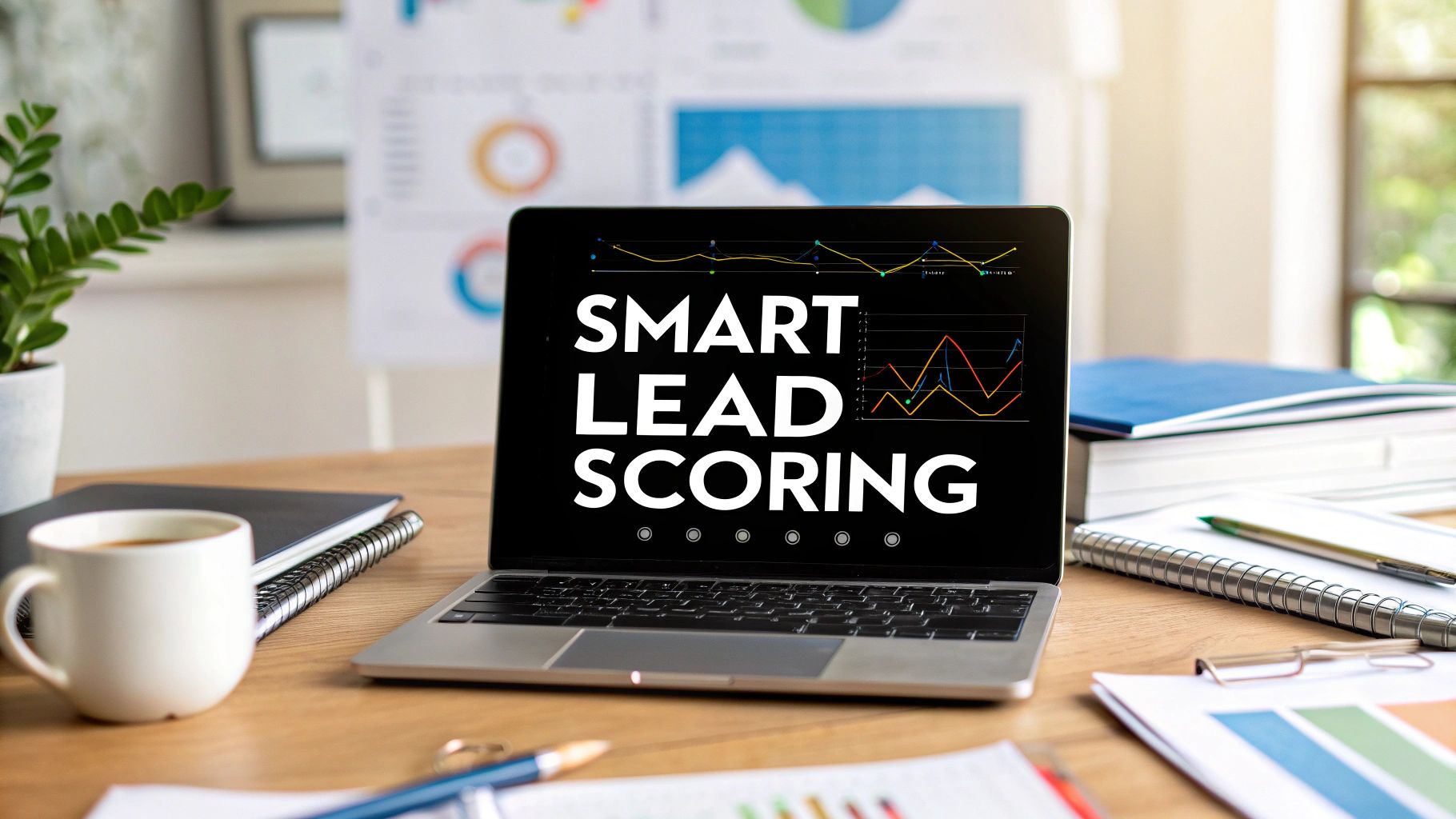
Have you ever chased a "hot" lead for weeks, only to discover it was a student working on a research paper? I've done that before.
I once wasted a whole quarter on leads that looked great on paper but had no intention of making a purchase. It was annoying and discouraging, and it cost a lot of time and coffee. At that point, I realized that our lead scoring was very wrong. We were counting clicks and downloads instead of figuring out what people wanted. Have you heard that before?
If you're tired of the guesswork and want to focus your energy on people who are ready to buy, you're in the right place. This isn't just another generic article. I’m pulling back the curtain on the lead scoring best practices I learned the hard way, filled with the exact strategies and mistakes that shaped our current, high-converting process.
We’ll move beyond simply tracking form fills and demo requests. True lead scoring is about identifying the right company profile (Ideal Customer Profile filtering) and then pinpointing specific buying signals that indicate they're ready for a conversation.
This guide provides a complete step-by-step tutorial. We'll dive deep into practical, actionable points that you can implement immediately. You will learn how to:
- Align your sales and marketing teams around a unified definition of a “qualified lead.”
- Implement both explicit and implicit scoring criteria to capture a 360-degree view of your prospects.
- Utilize negative scoring to eliminate unqualified leads and keep your pipeline clean.
- Continuously test and refine your model to adapt to changing market dynamics.
Think of this as your playbook that transforms your lead generation process from a volume game to a value game. Let's stop chasing ghosts and start closing deals with prospects who want to talk to you. Ready to build a smarter sales engine? Let's get started.
1. Define Clear Lead Scoring Criteria and Thresholds
Let's start at square one. What's the point of scoring leads if you haven't clearly defined what a "good lead" even looks like for your team? Winging it is a recipe for disaster. I’ve seen teams chase leads that were never going to convert, simply because their scoring system was a black box of vague rules. This is the foundation of any effective lead scoring best practice; without clear criteria, everything else crumbles.
Defining your criteria means creating a systematic, documented approach to evaluating a lead’s quality and readiness to buy. It’s about translating your Ideal Customer Profile (ICP) and buyer journey into a concrete points system. This involves combining who they are (demographics/firmographics) with what they do (behavioral data).

How to Build Your Scoring Model
Think of this as your lead evaluation Blueprint. It’s a crucial step that aligns your sales and marketing efforts, ensuring everyone is on the same page about which leads get priority.
Here's a simple, step-by-step approach:
- Identify Your ICP Fit: First, list the explicit attributes that make a lead a perfect fit. This is the "who." Examples include job title (e.g., VP of Sales, C-Level), company size (e.g., 50-500 employees), industry (e.g., SaaS, Manufacturing), and location.
- Pinpoint High-Intent Behaviors: Next, list the actions that signal buying intent. This is the "what." A demo request is a massive signal and should be treated as one. A pricing page visit is a strong indicator, while a blog subscription is a lower-intent, top-of-funnel action.
- Assign Points & Set Thresholds: Now, assign points to each criterion. For instance, Marketo often suggests weighting a high-value action, such as a demo request, at 25 points, while a simple blog visit might only be worth 2 points. Then, set a threshold for what constitutes a Marketing Qualified Lead (MQL) and a Sales Qualified Lead (SQL). A common practice, such as at HubSpot, is to use a 100-point scale where a lead scoring of 70 and above is deemed sales-ready.
What to NEVER do: Don't create a system with 50 different scoring rules from day one. You'll get lost in the complexity and won't know which criteria are actually impacting conversions. Start small and iterate.
At Gojiberry, we live by this. We first filter for our non-negotiable ICP criteria, like company size and industry. Only then do we start scoring based on behavioral signals. This two-step process ensures we aren't just scoring activity, but scoring the right activity from the right companies. It's a game-changer for focus and efficiency.
2. Implement Behavioral Lead Scoring
If a lead’s demographic data tells you who they are, their behavior tells you what they want. And isn't that what sales is all about? Relying mainly on static data, such as job titles, is like trying to sell a surfboard to someone who lives in the desert; it just doesn't make sense. Behavioral scoring shifts the focus from "are they a good fit on paper?" to "are they showing real buying intent right now?" It's the difference between a cold list and a pipeline of warm, engaged prospects.
This approach involves tracking and scoring leads based on their digital footprints across your website, emails, and content. It's about translating their actions, or lack thereof, into a numerical score that signals their interest level and sales readiness. Pioneers in this space, like Eloqua and Pardot, built their empires on this very principle: actions speak louder than titles.
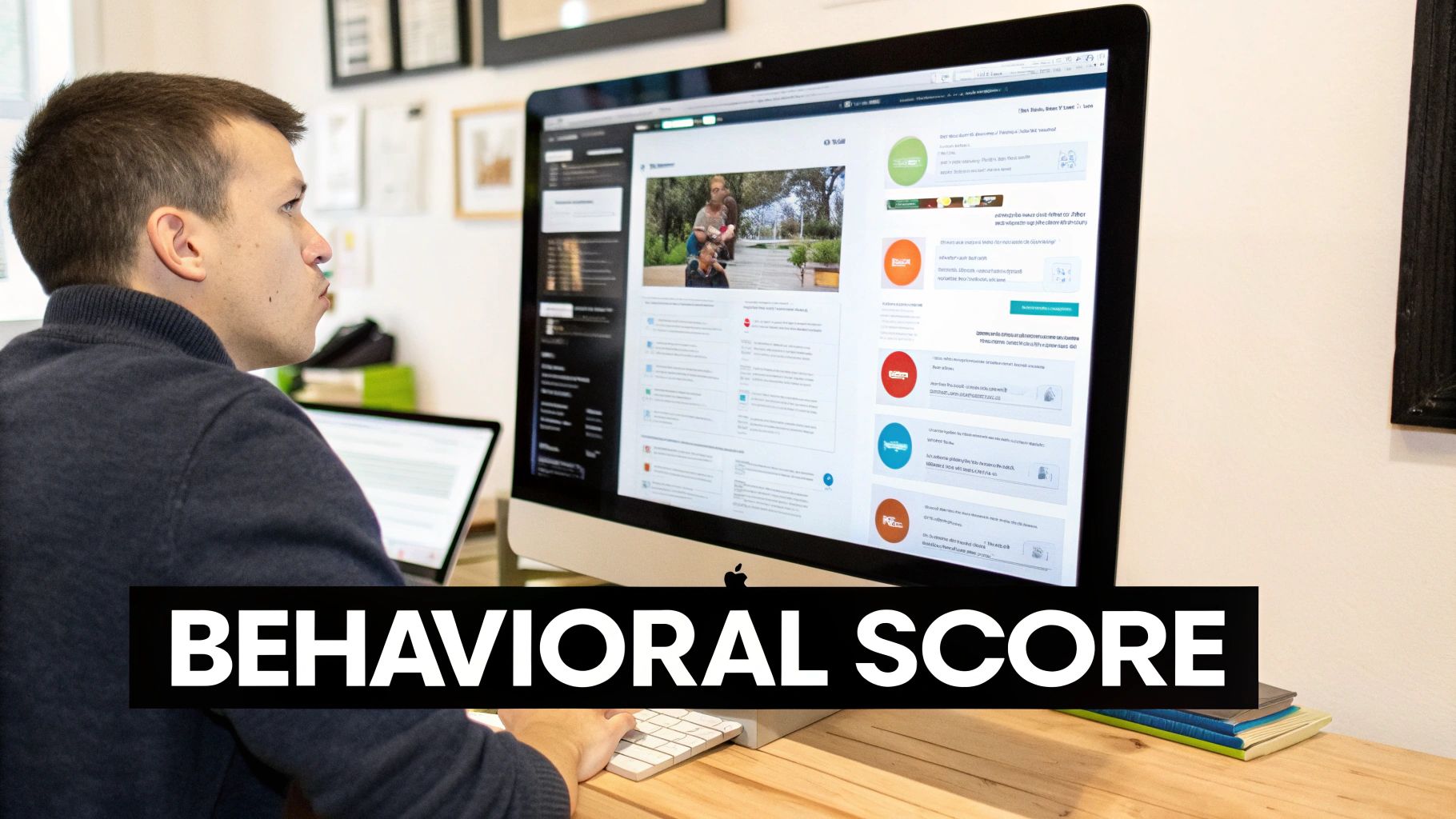
How to Build Your Scoring Model
Your goal here is to create a dynamic system that rewards high-intent actions and understands that not all engagement is created equal. A click on a pricing page is leagues more valuable than a social media follow.
Here's a simple, step-by-step approach:
- Map High-Value Actions: Identify the digital breadcrumbs that strongly indicate purchase intent. This is where you get specific. For example, Pardot often assigns 50 points for a pricing page visitation, while Adobe Marketo might boost a score for someone spending over 10 minutes on key product feature pages.
- Assign Behavioral Points: Create a hierarchy of actions. A demo request is a 10/10 signal and should get the highest score (e.g., +30 points). A visit to a competitor comparison page is another goldmine (+20 points). A webinar registration might be lower (+10 points), and a blog visit even lower (+2 points). You can find more examples of high-intent signals in our detailed guide.
- Implement Score Decay: A lead's intent isn't permanent. A demo request from six months ago is stale. Implement "score decay" rules where points expire or decrease over time (e.g., points lose 50% of their value after 30 days of inactivity). This keeps your scoring system relevant and focused on current interests.
What to NEVER do: Never treat all page views the same. A visit to your "Careers" page is not the same as a visit to your "Pricing" page. Context is everything. Scoring them equally will pollute your system and send sales on a wild goose chase.
At Gojiberry, we integrate behavioral scoring directly into our ICP framework. We don't just track any activity; we track the most relevant intent signals from our ideal prospects. This means we score a pricing page visit from a VP of Marketing at a 200-person SaaS company far more heavily than the same action from an intern. It’s about precision, not just volume.
3. Use Predictive Lead Scoring Models
Ready to move beyond manual rule-setting and let data science do the heavy lifting? Predictive lead scoring uses machine learning and AI to analyze historical data, identifying the subtle patterns and correlations that determine which leads are most likely to convert. I’ve seen teams get stuck trying to manually perfect their rules-based system, only to discover a predictive model could have pinpointed their best leads with 10 times the accuracy. This is one of the most powerful lead scoring best practices for a reason: it replaces guesswork with data-driven probability.
Predictive models crunch your historical sales data-both wins and losses-to build a profile of your ideal converting lead. Instead of you telling the system that a "VP of Sales" is valuable, the algorithm learns this by analyzing past deals. It can uncover non-obvious traits, such as leads from companies that recently received funding or those who interacted with a specific sequence of content, and assign scores accordingly. It's about letting the machine connect the dots that are invisible to the human eye.

How to Build Your Scoring Model
Implementing a predictive model isn't just for data scientists. Platforms like Salesforce Einstein and 6sense have made this technology accessible. However, a smart approach is key to getting real value.
Here's a simple, step-by-step approach:
- Gather & Clean Your Data: The model is only as good as the data it learns from. You need a solid foundation of historical data, ideally at least 12-18 months' worth of both converted and lost leads. Ensure this data is clean, complete, and consistent.
- Choose Your Predictive Tool: Select a platform that fits in your tech stack and needs. Salesforce Einstein Lead Scoring is a great native option for Salesforce users, while platforms like 6sense are known for their ability to identify anonymous buying signals across the web.
- Train, Validate, and Deploy: Feed your historical data into the model to train it. The tool will generate a predictive score for new leads. Critically, you must validate the model’s accuracy by comparing its predictions against actual outcomes over a set period before fully rolling it out.
What to NEVER do: Don't just "set it and forget it." A predictive model is a living system. Your market, product, and customers change, so the model must be periodically retrained with fresh data to maintain its accuracy and effectiveness.
At Gojiberry, we use a hybrid approach that combines the best of both worlds. We first apply our strict ICP filters to ensure we're only analyzing relevant companies. Then, we leverage predictive analytics to score the remaining accounts based on their likelihood to convert, layering this with real-time behavioral signals. This ensures our sales team receives a hyper-accurate, prioritized list of leads who are not just a good fit, but are ready to engage now. It’s all about intelligent automation.
4. Align Sales and Marketing on Lead Scoring
Ever seen a marketing team celebrate a record number of MQLs, while the sales team complains they have nothing to work with? This classic disconnect is a huge profit killer. A lead scoring system built in a marketing silo is worthless. If sales don't trust the score, they won't follow up on the leads, and all your hard work goes down the drain. This is why aligning sales and marketing isn't just a nice-to-have; it's one of the foundational best practices for Lead scoring.
True alignment means creating a collaborative framework where both teams jointly define, implement, and refine the scoring criteria. It’s about building a shared language and set of expectations. When sales agree on what constitutes a "good lead," they trust the MQLs they receive. This transforms Lead Scoring from a marketing metric into a powerful revenue engine.
How to Build Your Alignment Framework
Think of this as forging a peace treaty between two powerful nations: your sales and marketing departments. The goal is a unified front, not just a temporary ceasefire. This ensures that the leads marketing generates are precisely the ones sales are excited to pursue.
Here's a simple, step-by-step approach:
- Schedule a Kickoff Workshop: Get key stakeholders from both sales and marketing in a room (virtual or physical). The goal is to agree on the definition of an MQL. Ask sales: "What information and behaviors make you confident a lead is worth your time?"
- Co-Create the Scoring Rules: Utilize the insights from the workshop and build the scoring model together. Marketing can propose point values based on data, but sales must have the final say on whether an action (like a pricing page visit) truly indicates sales-readiness. Some companies, such as Oracle, use shared dashboards to make this process transparent.
- Establish a Feedback Loop: This is critical. Sales needs a simple, quick way to provide feedback on lead quality directly within the CRM. This could be a "Lead Quality Score" field or disposition reasons such as "Not a Fit" or "Bad Timing." This data is pure gold for refining your model.
What to NEVER do: Never launch a lead scoring model without getting explicit sign-off from sales leadership. If the leaders aren't bought in, the reps on the ground won't be either. The system will be dead on arrival.
At Gojiberry, we see this as a continuous dialogue, not a one-time meeting. We have standing bi-weekly syncs where we review lead quality feedback from sales. We analyze which scores led to conversions and which were duds, allowing us to tweak our model in near real-time. This feedback loop is essential for maintaining trust and ensuring our lead scoring best practices drive results.
5. Implement Negative Scoring and Lead Decay
What happens when a lead who looked promising suddenly goes silent? Or what about leads that fit some criteria but have red flags, like a personal email address or a competitor's domain? Ignoring these signals is like pretending a leak in your boat doesn't exist. This is where implementing negative scoring and lead decay becomes one of the most critical lead scoring best practices you can adopt. It keeps your pipeline clean and your scores honest.
This two-pronged approach ensures your lead scores are true reflections of current interest and fit. Negative scoring deducts points for undesirable attributes or actions, while lead decay gradually reduces a lead's score over time due to inactivity. Without these, you end up with inflated scores and a sales team chasing ghosts.
How to Build Your Scoring Model
Think of this as the quality control system for your lead scoring engine. It prevents bad data and disinterest from muddying the waters, ensuring that only actively engaged, high-fit leads rise to the top.
Here's a simple, step-by-step approach:
- Identify Negative Attributes & Actions: First, list the red flags. This includes explicit data, like using a personal email address (
@gmail.com,@yahoo.com), being from a non-target country, or having a job title like "Student" or "Intern." It also includes actions like unsubscribing from your emails. - Define Your Lead Decay Rules: Next, determine how and when a score should decrease. A common approach is to reduce a score if a lead hasn't engaged in 30, 60, or 90 days. The timeline should be based on your average sales cycle. For a short cycle, decay might kick in after 30 days. For a longer, more complex sale, 90 days might be more appropriate.
- Assign Negative Points & Decay Rates: Now, assign the point deductions. For example, Marketo often suggests deducting 10 points for a personal email. For decay, a platform like Pardot can be configured to reduce an inactive lead’s score by a set amount or percentage over time. For instance, a lead who hasn't opened an email or visited your site in 60 days could lose 20 points.
What to NEVER do: Don't set your decay rules so aggressively that promising leads who are simply in a long consideration phase get prematurely disqualified. The goal is to weed out the truly cold leads, not punish the slow-burners.
At Gojiberry, we use negative scoring to sharpen our focus. If a lead comes from an industry we don't serve or has a job title that hasn't converted, they receive negative points right away. This ensures that even if they download a dozen ebooks, their score won't get artificially inflated, preventing them from ever reaching our sales team's queue. This keeps our Reps focused exclusively on leads that have a real shot at becoming customers.
6. Regularly Test and Optimize Scoring Models
Ever felt like your lead scoring model is a "set it and forget it" machine? Big mistake. I once worked with a team that built a beautiful, complex scoring model and didn't touch it for a year. They couldn't figure out why their MQL-to-opportunity rate was plummeting. The market had shifted, their ICP had evolved, but their scoring was stuck in the past. Your model is a living system, not a stone tablet.
Regularly testing and optimizing your model is a non-negotiable part of lead scoring best practices. It's the process of continuously analyzing your model's performance against actual sales outcomes to ensure it remains accurate and effective. This means questioning your assumptions, testing new hypotheses, and adapting to new buyer behaviors and market dynamics. Without this, you're flying blind, making decisions based on outdated data.
How to Build Your Optimization Loop
Think of this as a continuous improvement cycle for your lead qualification engine. This process ensures your scoring criteria don't go stale and that your sales team is always working on the leads most likely to close. It's about data-driven refinement, not guesswork.
Here's a simple, step-by-step approach:
- Schedule Regular Reviews: First, get it on the calendar. Whether it's monthly or quarterly, schedule a dedicated meeting with sales and marketing stakeholders to review performance. Check the MQL-to-SQL conversion rate for different score brackets. Are high-scoring leads converting?
- Isolate and Test One Variable: Don't change everything at once. Pick one element to test, like the point value for a "Pricing Page Visit" or the weight of a specific job title. For example, Demandbase might test whether a "Director of IT" from a fintech company is more valuable than a "VP of Operations" from manufacturing and adjust the scoring accordingly.
- Analyze and Document: Run your test for a set period (e.g., one month) and analyze the results. Did the change improve the quality of sales-ready leads? Use statistical significance where possible. Document every change, the hypothesis behind it, and the outcome. This creates an invaluable log for future optimizations.
What to NEVER do: Don't make changes based on a single piece of anecdotal feedback from one sales rep. While qualitative input is valuable, all changes to the model should be validated by conversion data across the board to avoid bias.
At Gojiberry, this is vital to our operations. We perform quarterly analyses comparing the initial lead scores of closed-won deals to the closed-lost deals. And this has helped us identify which criteria are truly predictive. We recently discovered that leads interacting with our new integration marketplace converted 30% faster, so we immediately increased the score for that behavior. This constant tuning keeps our sales engine humming efficiently.
7. Create Multi-Touch Attribution Scoring
Is your lead scoring model giving all the credit to the last touchpoint? If a lead attends a webinar, downloads an ebook, and then requests a demo, rewarding the demo request is like giving a movie award only for the final scene. It ignores the entire character arc that led to the climax. This is a classic mistake that leaves marketing teams undervalued and blind to what's working.
Multi-touch attribution scoring is a more sophisticated lead scoring best practice that distributes credit across the various marketing interactions a lead has before converting. Instead of a simple "last-touch" model, it acknowledges that the journey is complex and multiple touchpoints contribute to building trust and intent. Platforms like Bizible (now Adobe Marketo Measure) and Google Analytics 360 have championed this approach, helping teams see the full picture of their marketing impact.
This minimalistic concept map illustrates how multi-touch attribution connects different touchpoint types to a weighting system that ultimately reflects their impact on conversion.
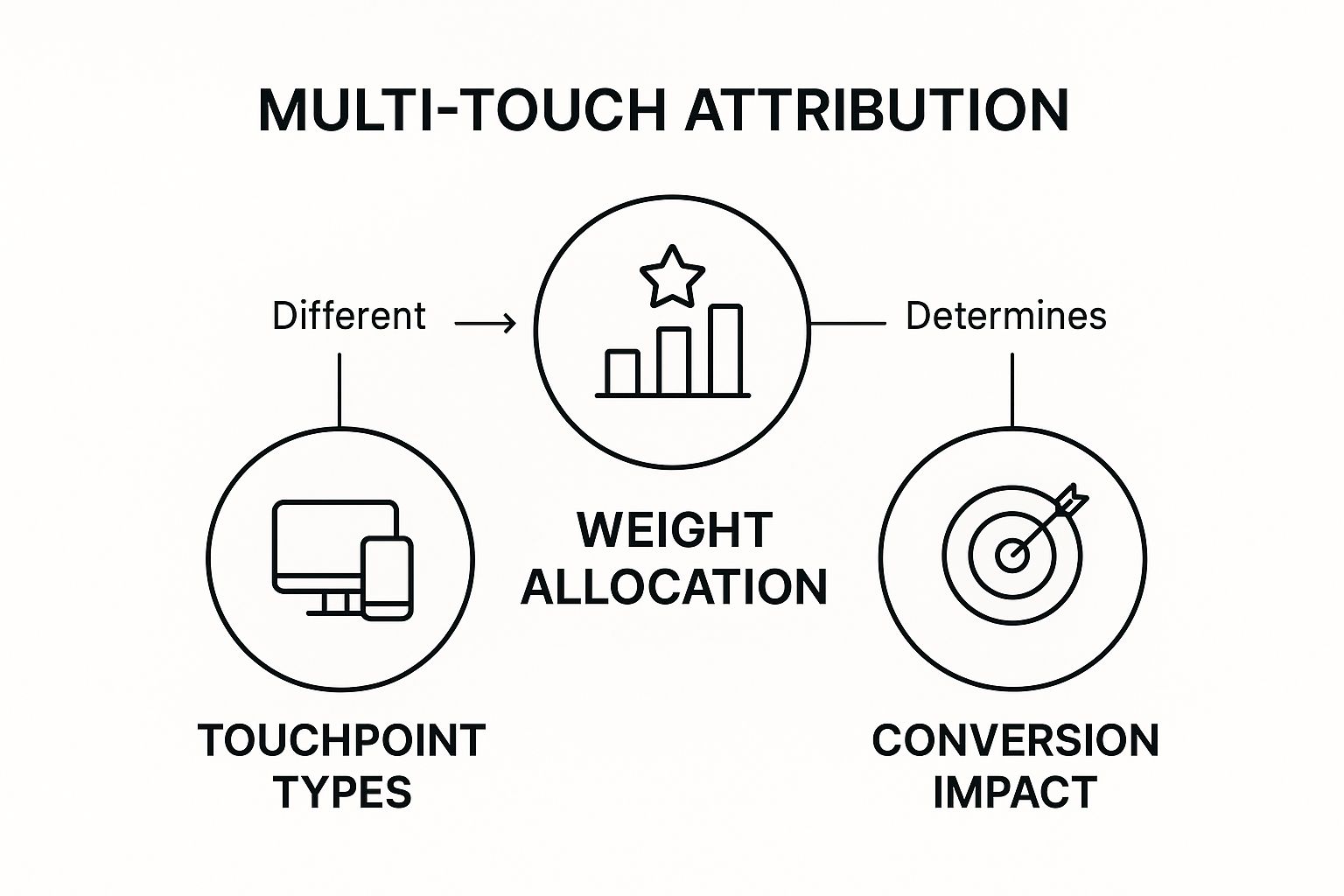
The visualization shows that assigning proper weight to each touchpoint is the critical link to understanding its true contribution to the final conversion.
How to Build Your Scoring Model
Implementing this isn't about making things impossibly complex. It's about adding nuance to your scoring so it more accurately reflects the real-world customer journey. A well-designed multi-touch system prevents you from over-investing in bottom-funnel channels while neglecting the top-funnel activities that feed them.
Here's a simple, step-by-step approach:
- Map Key Touchpoints: First, identify the common interactions on the path to purchase. This could include initial blog post visits, social media engagement, webinar attendance, ebook downloads, and finally, pricing page visits or demo requests.
- Choose an Attribution Model: Start small. A linear model gives equal credit to every touchpoint. A U-shaped model gives more weight to the first and last touches. As you gather more data, you can move to more advanced data-driven models that assign credit based on actual conversion influence.
- Assign and Test Point Values: Based on your chosen model, allocate points. For example, in a U-shaped model, the first touch (e.g., discovering your blog) and the lead-converting touch (e.g., demo request) might each receive 10 points, while middle touches (e.g., webinar) receive five points.
What to NEVER do: Don't jump straight to a custom, data-driven attribution model without the historical data to support it. You'll be basing your scores on guesswork. Start with a simpler model like linear or U-shaped, collect data, and then refine.
At Gojiberry, we recognize that understanding the complete narrative is crucial. While we prioritize high-intent signals, we also value the earlier interactions that build awareness and educate the prospect. By mapping the full B2B customer journey on gojiberry.ai, we can apply a more holistic scoring logic. This ensures our marketing team takes credit for nurturing leads from the very first touchpoint, leading to a smarter, more sustainable pipeline.
8. Implement Account-Based Lead Scoring
Have you ever had a "perfect" lead on paper: a VP from a target account, who goes cold? Meanwhile, a junior-level contact from another account is downloading every eBook you have. Traditional lead scoring would tell you to focus on the junior contact. But what if the VP’s company is showing massive buying intent across multiple departments? This is where standard lead scoring falls flat, and one of the most powerful lead scoring best practices, account-based scoring, takes over.
In B2B, you're not selling to an individual; you're selling to a buying committee within a company. Account-based lead scoring shifts the focus from individual lead scores to a holistic, account-level view. It aggregates engagement signals from multiple stakeholders within a target account, leaving you a far more accurate picture of an organization's true buying intent. This approach prevents you from missing out on hot accounts just because your single point of contact hasn't hit an MQL threshold.
How to Build Your Scoring Model
Think of this as creating a "company-wide" interest score. It’s about recognizing that a demo request from a decision-maker, combined with research from an end-user and a visit to your pricing page from someone in finance, is a massive buying signal. Platforms like 6sense and Demandbase excel at this by tracking these disparate touchpoints and rolling them up into a single, actionable account score.
Here's a simple, step-by-step approach:
- Define Target Account Criteria: First, forget individual leads. What does a perfect account look like? List your ideal firmographic data: industry, company size, revenue, technology stack, and signs of growth, such as recent funding or hiring sprees.
- Track Account-Level Engagement: Identify behaviors that indicate account-wide interest, such as tracking multiple contacts from the same company visiting your website, high-value page views (pricing, case studies) from different stakeholders, and intent signals from third-party data providers. Further showing the account is researching your category.
- Combine and Prioritize: Create a scoring model that blends individual lead scores with the overall account score. For example, a high-scoring individual (e.g., a Director of IT) within a high-scoring account is your top priority. An intern in a high-scoring account is valuable, as they signal that internal research is happening. An individual director in a low-scoring account might be a lower priority.
What to NEVER do: Don't treat all contacts within an account equally. A CEO's engagement is worth exponentially more than an intern's. Your model must weigh scores based on a contact’s likely role and influence in the buying committee. Ignoring seniority is a surefire way to misinterpret account intent.
At Gojiberry, we integrate this logic directly into our process. We start with our defined ICP to identify high-fit accounts. Then, we monitor the entire account for buying signals, not just one person. If we see activity from multiple contacts, even if none of them individually qualify as an MQL, the account score skyrockets, flagging it for immediate outreach. It’s about spotting the fire, not just the smoke.
Lead Scoring Best Practices Comparison
Your Turn: Go From 'Busy' to 'Effective'
We’ve covered a ton of ground, haven't we? From defining your ideal customer with laser precision to aligning your sales and marketing teams so they function like a single, revenue-generating machine. We’ve explored the nuts and bolts of behavioral scoring, the forward-looking power of predictive models, and the critical importance of negative scoring to keep your pipeline clean.
The journey through these lead scoring best practices isn't just about adopting new software or adding more data points. It's about a fundamental shift in mindset. It’s moving away from the "more is better" approach that leaves sales Reps swamped with low-quality leads and embracing a "smarter is better" philosophy. I’ve been there, staring at a CRM filled with thousands of "leads" that were nothing more than digital ghosts. It was busy work, not effective work. The real turning point comes when you stop chasing every form fill and start focusing only on the conversations that matter.
The Core Takeaway: Clarity Over Complexity
If you remember just one thing from this entire guide, let it be this: Effective lead scoring is built on clarity, not complexity.
You don't need an algorithm worthy of a NASA launch to succeed. What you need is crystal-clear alignment on three fronts:
- Clarity on Who: A rigorously defined Ideal Customer Profile (ICP). Not a vague description, but a detailed blueprint of the companies that get the most value from your solution and, in turn, provide the most value to you.
- Clarity on What: A focused set of high-intent buying signals. You must know which actions truly separate the curious browsers from the serious buyers ready for a conversation. Is it visiting the pricing page three times in a week, or is it downloading a specific, bottom-of-funnel case study?
- Clarity on Process: A seamless, agreed-upon handoff between marketing and sales. Everyone needs to speak the same language, understand what an "MQL" or "SQL" truly means, and trust the system to deliver qualified opportunities.
Without this foundation of clarity, even the most advanced scoring model is just a fancy way to organize noise. With it, your sales team transforms from being perpetually busy to being ruthlessly effective. They stop wasting cycles on dead-end leads and invest their energy where it counts: building relationships and closing deals.
Your Action Plan: Stop Reading, Start Doing
Knowledge is great, but action is what generates a pipeline. Reading about lead scoring best practices is the first step, but the next step is to make it real. Don't let this be another tab you close and forget.
Here’s your immediate, actionable game plan. No excuses, this will take you 15 minutes:
- Step 1: Open a blank document or spreadsheet. Right now.
- Step 2: Define Your ICP (The "Good Enough" Version). Don't overthink it. List 3-5 firmographic and technographic traits of your best customers. (e.g., Industry: SaaS, Company Size: 50-250 employees, Tech Used: Salesforce, HubSpot).
- Step 3: Brainstorm 5 High-Intent Signals. What are the top 5 actions a lead could take that make your sales team say, "I need to call them now"? Write them down. Think about website behavior, content engagement, and demo requests.
- Step 4: Schedule a 30-Minute Meeting. Invite key stakeholders from both sales and marketing. Title it "Drafting Our Lead Scoring v1." Use your doc as the starting point for the conversation.
Congratulations on taking the most important step in lead scoring. You have begun the process and generated the needed momentum to create a system that supports steady growth. You've moved past being busy to being effective. Success is within your reach.
Frequently Asked Questions
H3: How is what Gojiberry does different from traditional lead scoring?
Traditional lead scoring combines fit (ICP) and intent into a single score, often misreading leads. Gojiberry changes this by first filtering for your Ideal Customer Profile. Companies that don't match your criteria are excluded from scoring. Only those that pass the ICP filter are assessed for buying signals. This ensures your sales team engages only with high-fit companies showing genuine intent, focusing on quality over quantity.
H3: Do I need a ton of historical data to start lead scoring?
It's a misconception that you need years of perfect data to begin. You can start with a simple model based on the current knowledge of your best customers. Consult your top sales Reps on common traits and key actions of successful deals. Use these insights to create your initial version. You can refine it with predictive modeling as you collect more data. Start now; waiting for a perfect dataset isn't necessary.
H3: What's the biggest mistake people make when setting up lead scoring?
The number one mistake I see is building the model in a marketing vacuum. Marketing creates what they believe is a perfect scoring system, launches it, and then wonders why sales aren't converting the leads. If the sales team doesn't trust, understand, or agree with the criteria defining a "sales-qualified lead," they will ignore it. The system becomes useless.
What to do: Get sales leadership in the room from day one. Co-create the definitions and point values. Establish a loop that allows sales to provide feedback on lead quality. Without sales buy-in, you're just creating vanity metrics for marketing.
More High-Intent Leads = Your New Growth Engine.
Start Now and Get New High Intent Leads DeliveredStraight to Slack or Your Inbox.







